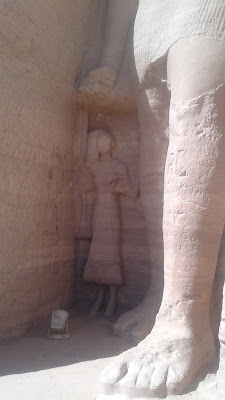HISTORY
Ancient Egyptians were talented sculptors that mastered the art of transforming stone blocks into magnificent statues and structures. The most prevalent of these structures is the obelisk - a slender monolithic styled stone consisting of four sides and pyramidal shaped top. The first historical record of an obelisk dates to around 2575 BC with these early models reaching a modest height of 10 feet. With time, Ancient Egyptians would eventually create obelisks measuring a staggering 100 feet tall and had it been completed, the Unfinished Obelisk would have been the tallest at approximately 120 feet in height.
Obelisks were created from red granite using dolerite balls, dolerite being a volcanic rock. Once the obelisks were quarried, they were transported to temples throughout Egypt which was a process that would take several months. At the temples, the obelisks would be erected in front of the main pylons and covered in electrum, an alloy composed of gold and silver.
 |
| Obelisk in front of Luxor Temple. |
FAST FACTS
One of the oldest surviving obelisks belongs to Senusret I, pharaoh who ruled Egypt from 1971 to 1926 BC during the 12th dynasty.
The Unfinished Obelisk would have measured an estimated 120 feet in height and weighed over 1,150 tons.
Queen Hatshepsut, who ruled during the 18th dynasty, is the only Ancient Egyptian woman to have built obelisks. All others were built by men.
 |
| Queen Hatshepsut's obelisk at Karnak. |
Many Ancient Egyptian obelisks were taken from Egypt and relocated around the world - Rome, Italy; New York City, United States; London, England; St. Peter’s Square, Vatican City; Paris, France.
The tallest Ancient Egyptian obelisk is the Lateran Obelisk which now stands in Rome, Italy.
VISITING THE UNFINISHED OBELISK
The Unfinished Obelisk is located in Aswan and a stop to this site seems to be included on most tour itineraries. A visit to the site does not last long, generally 30 to 60 minutes, since there is not much to see, just the obelisk. During my first visit to the the Unfinished Obelisk, tourists had the opportunity to watch a short documentary on the history of obelisks and how Ancient Egyptians constructed them; however, when I went in 2018, there was no film. My tour guide stated that it has been a long time since the documentary was last shown.
NOTE This site is definitely not suited for those with mobility issues. The walkways are not paved, there are no railings, and some climbs and descents can be steep. Also, there are loose rocks throughout the quarry so it is important to watch your step.
NOTE One of the stores at the site is a bookshop from the American University in Cairo. This store is wonderful in that everything is a fixed price, so no haggling, and the books and items sold are of great quality. Between my two visits, I have purchased about $200 in books that are not sold, or are difficult to find, outside of Egypt. I have also purchased some beautiful bookmarks and postcards and one tour mate on my recent trip bought a few handmade dolls.





















